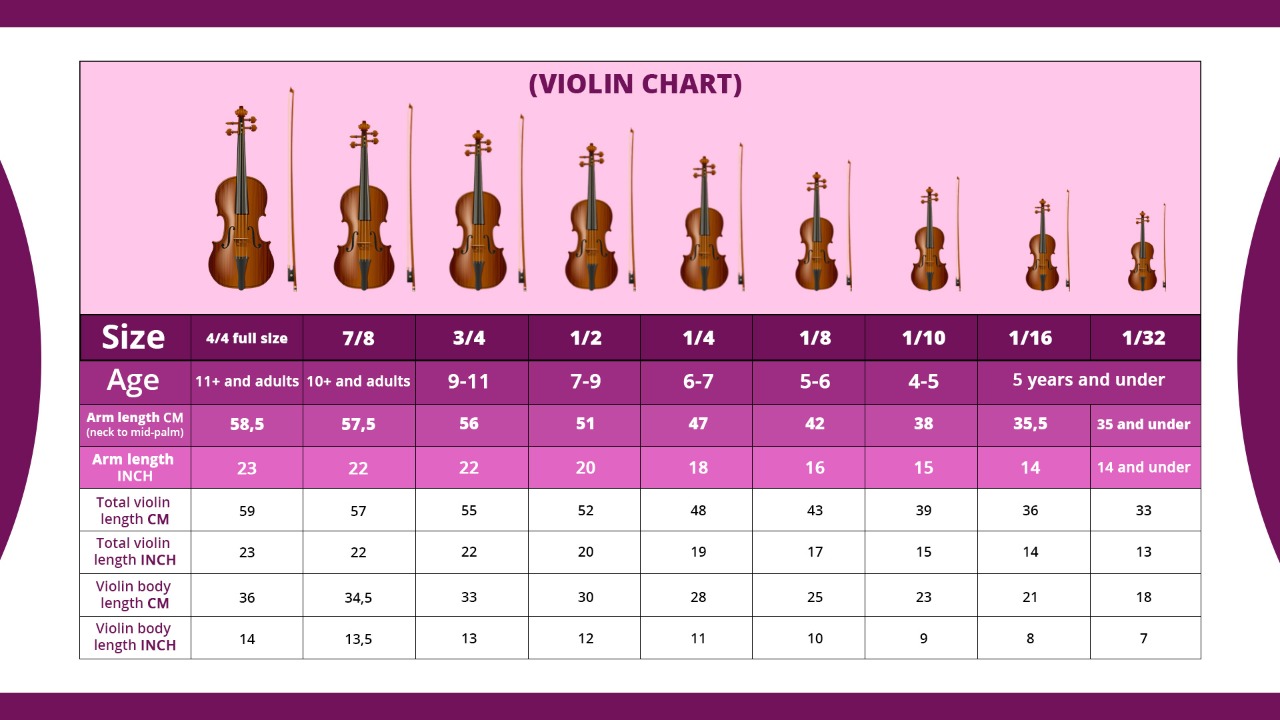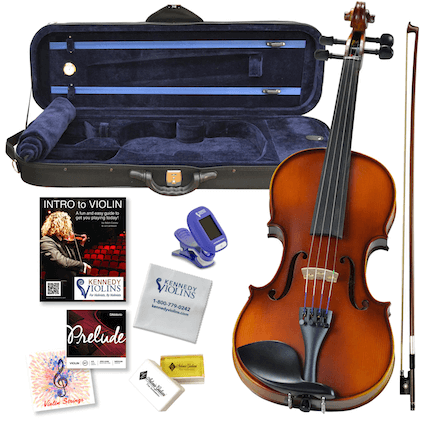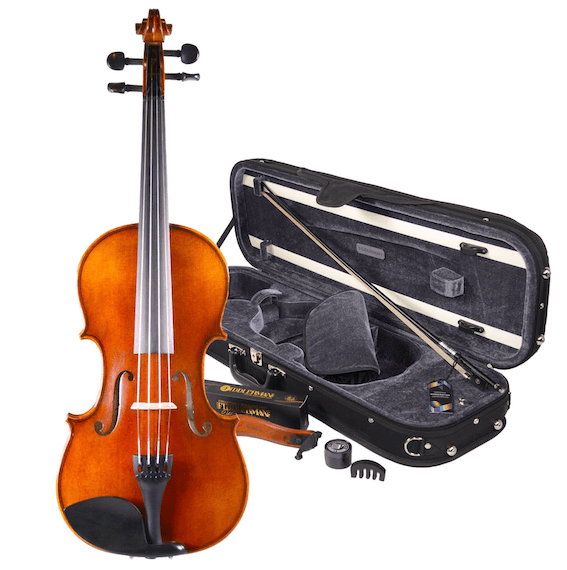Violin Size Chart: choose the right size violin
Did you know that violins come in a variety of sizes?
Selecting the correct size for you (or your child) is absolutely vital for fostering a happy and healthy violin journey.
Playing on a violin that is too big forces the player to contort their body into unnatural positions, possibly leading to injury (namely carpal tunnel and tendonitis); and playing on a violin that is too small can cause the player to feel very cramped and limited in their bowings and finger placements. Keep reading this article to discover what violin size is best for you or your child.

How do I know what violin size I need?!
The size of violin you need is based on your height and arm length. Age is also taken into consideration, however, all children grow at different rates, so when in doubt, choose a violin compatible with the child’s size rather than their age.
What if my child is between two violin sizes? Do I choose the larger or the smaller one?
If you find that you or your child are right on the cusp between two sizes, choose the smaller size to prevent any risk of injury. It might not seem economical and you might be afraid that your child can’t enjoy that size for a long time. In that case, choose to rent a violin or inform about the options to size up the violin you bought later. Lots of violin shops offer these possibilities.
Note that the exact measurements of violin sizes are not very standard. There are for example larger and smaller 1/8 violins. If your child is between violin sizes, see if the violin shop has a relatively larger or small version of the size you’re looking it. That can be just right. Full sized 4/4 violins are usually consistent in measurement. The variety is in children’s sizes.
There are nine different violin sizes to choose from
Full size 4/4 violin
A full-size violin is 59 centimeters (or 23 inches) long, from scroll to endpin. If you are an adult learner, you will more than likely need a full-size violin (with the exception of shorter adults, under five feet). Children typically graduate to a full-size instrument around 11 or 12 years old. In order to comfortably play a full size, your left arm should be 58.5 centimeters (or 23 inches) long, from the base of your neck to the middle of your palm.
⅞ size violin
A ⅞ size violin is 57 centimeters (or 22 inches) long and is geared towards those with an arm length of 57.5 centimeters (or 22 inches). ⅞ violins are sometimes referred to as the “ladies violin” because they are just ever so slightly smaller than the full size and therefore thought to be more suited towards women (but men can use them too!). Adults may choose to try a ⅞ size instrument if they experience any pain or discomfort when playing a full size, and children who are too big for a ¾ but not quite ready for a full size may also benefit from using a ⅞. ⅞ violins are not very common, so you may have to look a little harder to find one.
Important note: fractional violins (which are any size violin beside a full size) will not sound as full (or loud) as a full size.
¾ size violin
A ¾ size violin is 55 centimeters (or 22 inches) long. To comfortably fit a ¾ size violin, your arm should be about 56 centimeters (or 22 inches) long. Students around ages 9-11 typically use a ¾ size violin, but they can also be used by small adults.
½ size violin
A ½ size violin is 52 centimeters (or 20 inches) long and best suited for players with an arm’s length of 51 centimeters (or 20 inches). Children around ages 7-9 typically use half-size violins. In my experience, the jump from ¼ to ½ size is typically the biggest of the fractional sizes, so err on the side of caution when bridging this gap. Remember: it’s far worse to play on a violin that is too big than one that’s too small!
¼ size violin
A ¼ size violin is 48 centimeters (or 19 inches) long. To use a ¼ size violin, a child’s arm should be around 47 centimeters (or 18 inches) long, and they will most likely be around 6-7 years old.
⅛ size violin
A ⅛ size violin is 43 centimeters (or 17 inches) long and is best suited for children with an arm’s length of 42 centimeters (or 16 inches). This is usually around 5-6 years of age.
Sometimes it might make sense to start a 4 year old on a relatively small 1/8 violin. The sound is a lot better than the smaller sizes, which is motivating for your budding little fiddler. Also very small sized violin have a tiny bridge and the strings are close together, which makes it difficult to bow on one string and to cross strings.
1/10 size violin
A 1/10 size violin is 39 centimeters (or 15 inches) long. Children around ages 4-5 typically use this size, and their arm’s length should be about 38 centimeters (or 15 inches) long.
The step from 1/16 to 1/8 is quite big, so a size in between might be very convenient. Unfortunately when you order a 1/10 online often a 1/16 is delivered. Before buying check what the measurements are or (best!) try the instrument out, so you know it’s the right fit.
1/16 size violin
A 1/16 size violin is 36 centimeters (or 14 inches long). 1/16 size violins are typically best suited for children with an arm’s length of 35.5 centimeters (or 14 inches), generally under the age of 5.
Note that the sound of this size usually isn’t that good as the soundbox is simply too small for a pitch that’s meant for a 4/4 violin. If your child still plays a lot of open strings, sometimes it can make sense to start on a larger size (a 1/10 or maybe a small 1/8). By the time they play with all fingers, they might also be big enough for that larger size.
1/32 size violin
A 1/32 size violin is 33 centimeters (or 13 inches long). These are meant for extremely young children (between the ages of 2-5). Their arms-length should be 35 inches (or 14 inches) or under.
This size isn’t used that much as (frankly) they sound awful, it’s extremely difficult to bow an open string without hitting neighboring strings due to the small bridge and usually two and three years old can already handle a 1/16 violin.
What violin bow size do I need?
The violin bow corresponds in size to the violin size. Smaller violins come with shorter bows. This is all related to your arm length: with a bow that’s too long, you wouldn’t be able to bow at the tip. Also a longer bow is heavier and difficult to handle for small children.
The only exception to this is that with a 7/8 violin, adults usually choose for a 4/4 bow as there’s much more choice in full sized bows. 7/8 bows do exists, but are even more rare than 7/8 violins.
When getting used to a bigger size it can make sense to keep playing with the smaller sized bow for a little while. In this way your child doesn’t need to get used to a new size violin AND a new size bow at the same time.
How do I measure myself to see which size violin I should get?
Great question! There are two ways of measuring yourself (or your child) to see which violin size would work best. The first is to just take a tape measure, place it at the nape of your neck, and extend it to the middle of your left palm. When doing this, your arm should be held out so that it’s parallel to the ground. Once you have your measurement, you can use the chart here to determine which size would fit best. This method works great if you’re just starting out and don’t have an instrument to compare your arm’s length to.
The second way works best if you already have an instrument and are trying to figure out if it’s too big or too small. Place your violin in playing position (on your shoulder) and extend your left arm out so that it is straight. Notice where the violin makes contact with your arm. Ideally, the tip of the violin scroll should sit at your wrist. If you notice that the scroll is in your palm, you need to size down, and if the scroll stops anytime before your wrist, you need to size up.
If you’re feeling uncertain about choosing the right size, many shops will size you or your child for you. It never hurts to ask!
How to handle sizing up: changing to a bigger violin size for kids
Changing the size of your violin can throw everything out of whack! When switching to a bigger instrument, the spacing between your fingers will feel bigger, your bow will feel longer and more unwieldy, and the instrument may feel heavier as well. For at least the first week of playing on a bigger size, stick to pieces that you know well so that you just need to focus on getting used to how this new instrument feels and sounds!
Look up your right violin size based on age and (most important) arm length:
Violin size
Age in years
Arm length INCH
Arm length CM
Violin buying tips from a violin teacher
Once you’ve figured out the size, it’s time to buy your violin! Here are two violins I’ve tested and approve as a violin teacher. Please note that the sizes are a bit different per shop and maker, so I’ve added size charts specifically for these makers.
Ricard Bunnel G2 Student Violin Outfit
by Kennedy Violins
Available in all sizes this is a great instrument to start playing the violin. The sizing is relatively small in the small sizes (see below). I personally use the 1/8 size for my four year old daughter and we both love it. Sizes go from 1/16 to 4/4.
Ricard Bunnel violin sizing
Violin size
Violin body length
Total violin length
Fiddlerman Concert Violin Outfit
Excellent student violin with great sound. Watch my review video here. Sizes go from 1/16 to 4/4. There’s also a 7/8 size, which is great for some adults or kids who are in between 3/4 and 4/4.
Fiddlershop violin sizing
Violin size
Violin body length
What about the viola?
The viola has different sizes than the violin. Find my viola size chart right here.
What size violin do you play?
I hope this article has given you some clarity about all the different violin sizes. Make sure to bookmark this page, so you’ll always have this handy violin size chart at hand.
What size violin do you currently play? Let me know in the comments!



Is there any type of stick on finger board guides/markers or tape measurements for the 7/8 violins ? there are many of makers for these violins but i can’t find any helpful information from them on this.Thanks.
I never recommend stickers on the fingerboard. Instead use this D’Addario micro tuner for violin. That works no matter the size of the instrument.
The fractional sizes get too tiny. Once a child is in fifth grade, they can usually handle a full size 4/4 violin. Try it before you buy it!
Violins are a small instrument, even the full size 4/4 violin is small when you compare it to a 15″ or 16″ Viola.
what size should i chose if my arm is 28 inches long?
Violins don’t go bigger than full size, so that’s the choice.
It’s kind of funny because it says a ¼ violin is 19 inches & requires an arm length of 18”, but the ½ is 20” & requires an arm length of 20”. That doesn’t seem to add up. Why is the arm 1” shorter for the ¼, & equal in the case of the ½. By the way my daughters arm length is 19” & she’s turning 8 years old.
In the table there are some rounding differences. I guess with that age and arm length, 1/2 would be ideal for your daughter.
FYI
We don’t “air” on the side of caution. We “err” on the side of caution.
That one just jumped out at me. There are likely more. Consider hiring a proofreader. It’s a simple mistake that spellcheck won’t catch, but a proofreader would have saved it. Good luck. The information here is good. Thank you.
Thanks for correcting that. Unfortunately I don’t have the budget for a proofreader.
“Scale length” is super important, especially since violin bridges aren’t fixed in place (and can tilt). Even a small variation can throw intonation off; after a string change, minor accident, etc., I’ve thought I had the bridge positioned correctly only to measure (after finding my intonation is “off”) the scale length can be as much as 1/4″ off plus or minus. Proper scale length – the part of the string that is free to vibrate between the nut and the bridge – on a 4/4 is lucky 13″.
Thanks for sharing, Phil!
My daughter is 12 1/2 and her arm length is 24in. But, she’s only 4′ 9″ tall. Should she use a full-sized violin? Thanks.
I would try one and see how she does. Also a 7/8 is an option that she might find comfortable.
And do you measure with your arm by your side or parallel with your shoulder?
It’s neck to mid-palm with your arm stretched forward in the direction you would hold the violin. When in doubt, try out an actual violin, because that says more than measurements.
Ok thanks!
My son has dwarfism and is very small. He is four years old, but his arm is only 10 inches from palm to neck. Do you know if the 1/32 be small enough?
yes, that will work, certainly because in the beginnen stages one mainly plays open strings.
My arms are long enough for a 4/4 violin. However, my 70 year old left hand fingers have a hard time with stretches. Would a 7/8 violin suit me better?
Yes, you could definitely try. For some people it really is a relief.